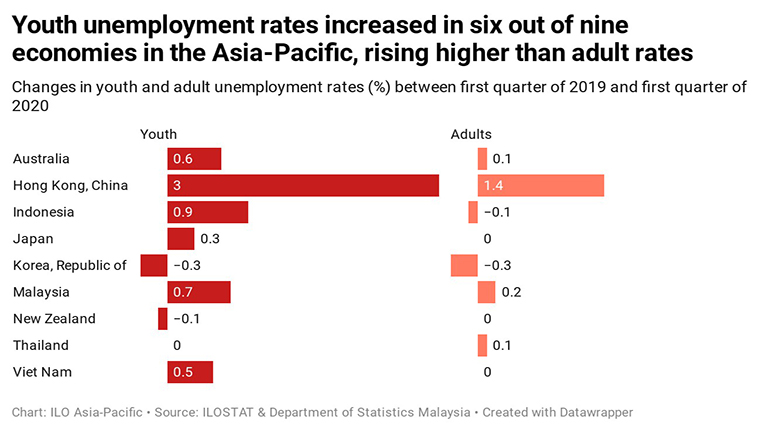New ILO-ADB report addresses the impact of COVID-19 on youth employment in Asia and the Pacific

Young people’s employment prospects in Asia and the Pacific are severely challenged as a result of the coronavirus disease (COVID-19) pandemic. Youth (15–24 years) will be hit harder than adults (25 and older) in the immediate crisis and also risk bearing higher longer-term economic and social costs, says a new ILO-ADB report.
‘Tackling the COVID-19 youth employment crisis in Asia and the Pacific ’, by the International Labour Organization (ILO) and Asian Development Bank (ADB), calls on governments in the region to adopt urgent, large-scale and targeted measures to generate jobs for youth, keep education and training on track, and to minimize future scarring of more than 660 million young people in the region.
Even before the COVID-19 crisis, youth in Asia and the Pacific faced challenges in the labour market resulting in high unemployment rates and large shares of youth excluded from both school and work. In 2019, the regional youth unemployment rate was 13.8 per cent compared to 3.0 per cent for adults, and more than 160 million youth (24 per cent of the population) were not in employment, education or training (NEET). Four in five young workers in the region were engaged in informal employment – a higher share than among adults – and one in four young workers was living in conditions of extreme or moderate poverty.
“The pre-crisis challenges for youth are now amplified since COVID-19 hit. Without sufficient attention, our fear is that this risks creating a ‘lockdown generation’ that could feel the weight of this crisis for many years to come,” says Sara Elder, a lead author of the report and Head of the ILO Regional Economic and Social Analysis unit.
The report cites three ways in which young people are affected in the current crisis: (1) job disruptions in the form of reduced working hours and earnings, and job losses for both paid workers and the self-employed; (2) disruptions in their education and training; and (3) difficulties in transitioning from school to work, and moving between jobs in a recession.
Youth unemployment rates in the region increased sharply in the first quarter of 2020 from the last quarter of 2019. Compared to the first quarter of 2019, the youth unemployment rate increased in six of the nine economies with available data: Australia, Indonesia, Japan, Malaysia, and Viet Nam, as well as in Hong Kong, China, which showed the largest increase of 3 percentage points. In all these economies, youth rates increased more than adult rates.

Disruption to youth employment in hard-hit sectors
Between 10 and 15 million youth jobs (full-time equivalent) may be lost across 13 countries in Asia and the Pacific in 2020, according to the report’s projections. In Cambodia, Fiji, Nepal, Pakistan, the Philippines and Thailand, youth unemployment rates are expected to reach at least double the 2019 estimates. According to the report, one of the reasons young people in the region face greater labour market disruption and job losses than adults is that nearly half of them (more than 100 million) were employed in the four sectors hardest hit by the crisis: the wholesale and retail trade and repair; manufacturing; rental and business services; and accommodation and food services. Young women are overrepresented in three of the four most affected sectors, particularly in accommodation and food services.
Compounded by the forced suspension of education and training, the COVID-19 crisis will affect young people’s transitions to and within labour markets, and could result in scarring effects, as seen in previous crises, says the report.
Tackling the youth employment crisis in Asia and the Pacific
The report recommends urgent, large-scale and targeted responses, including youth-targeted wage subsidies and public employment programmes, and measures to mitigate the impact on students of the disruption to their education and training. Governments should consider balancing (i) the inclusion of youth in wider labour market and economic recovery measures, with (ii) youth-targeted interventions to maximize effective allocation of resources.
“Prioritizing youth employment in the COVID-19 recovery process will improve Asia and the Pacific’s future prospects for inclusive and sustainable growth, demographic transition and social stability,’’ says Chris Morris, Head of the ADB NGO and Civil Society Center, and leading ADB’s Youth for Asia initiative.


